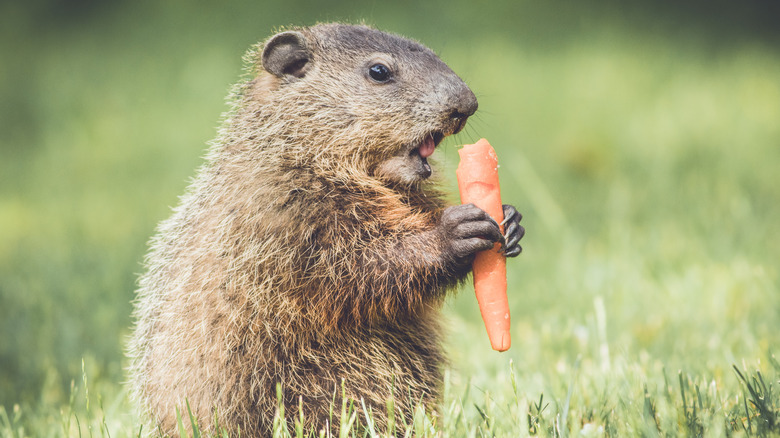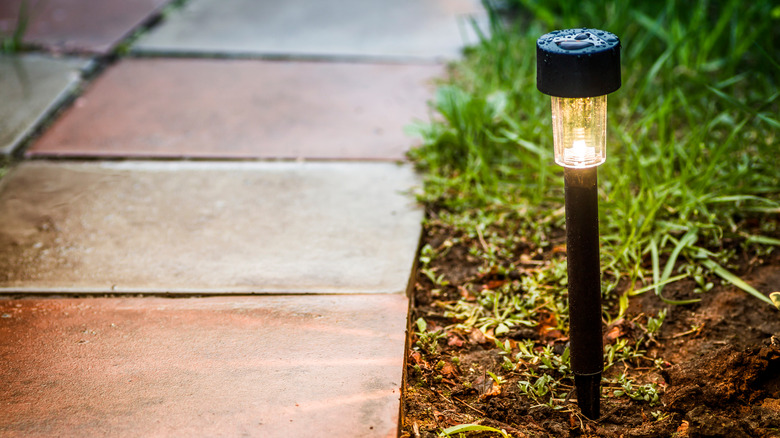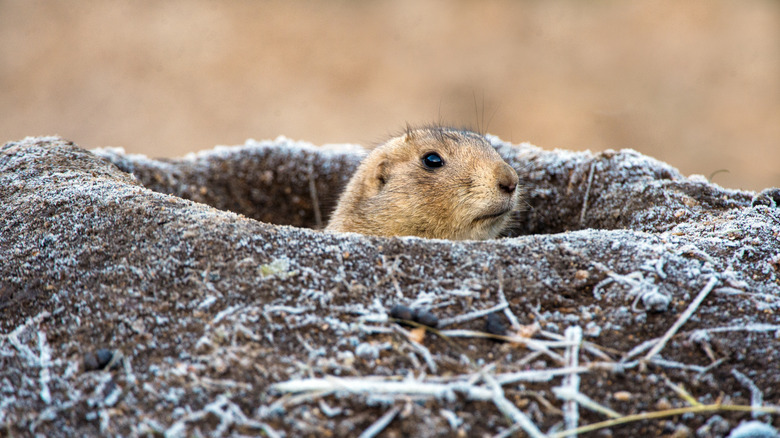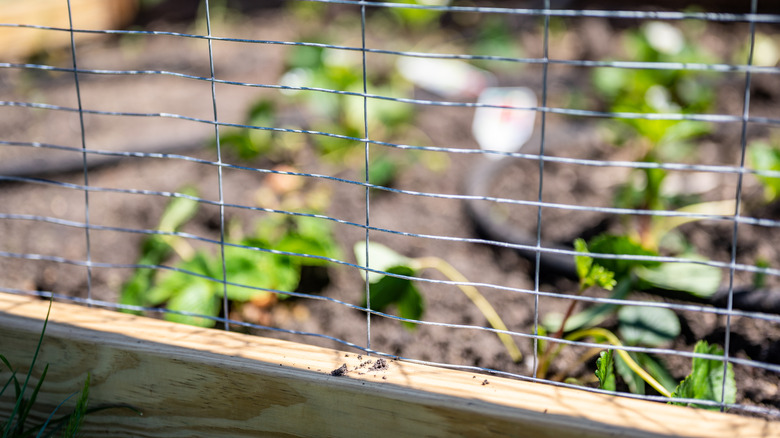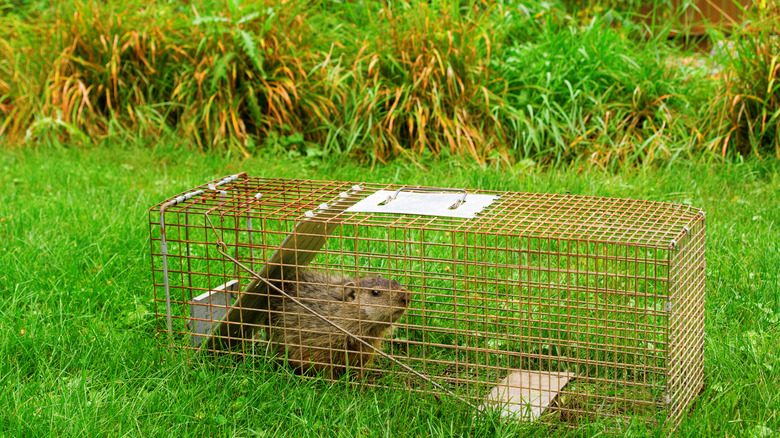10 Helpful Ways To Keep Groundhogs Out Of Your Garden
We may receive a commission on purchases made from links.
Dealing with groundhogs in your garden can sometimes feel like an endless struggle. While they might seem harmless, these burrowing animals can become a real nuisance, feasting on your carefully nurtured plants and destabilizing the ground with their extensive burrows. However, there's good news: Simple yet effective methods can help get rid of them. The Humane Society of the United States recommends using benign and non-lethal methods to deter these animals. This may include using kitty litter and sealing entrances. Other interesting methods include using motion-activated sprinklers, installing bright lights, scattering human hair, or even employing the scent of predator urine.
That being said, knowledge is power. Understanding what attracts them in the first place and how they operate can make your garden less appealing to them. Groundhogs, also known as woodchucks, are drawn to gardens primarily for food and shelter. The lush environment offers them an abundance of delicious vegetation to feed on. Moreover, the soft soil of gardens is ideal for groundhogs to dig and create their burrow systems. Groundhog burrows can have several entrances and extend underground over large areas. They not only serve as homes for these rodents but also as complex escape systems, which can be problematic for homeowners. In light of this information, it's important to ensure quick elimination. Keep in mind that although groundhogs spend lots of time under the ground, they are also known for climbing. So, you might need to combine various methods for successful elimination.
Motion sprinklers can startle groundhogs
According to the International Congress of Phonetic Sciences, groundhogs are shy creatures that get scared very easily. Sudden movements or noises can quickly deter them, which makes the use of motion-activated sprinklers ideal. When these devices detect movement, they unleash a sudden burst of water that startles groundhogs. This deterrence method capitalizes on the groundhogs' natural aversion to noises and potential threats, making your garden a less inviting place for them. To effectively set up motion-activated sprinklers, it's essential to understand this rodent's day-to-day schedule. Being creatures of habit, they usually have a routine, with their feeding times being in the morning and afternoon. With close observation, you can map out their path and disrupt their regular pattern by placing the sprinklers along their feeding route, maximizing the chances of deterring them. You can also position the sprinklers to cover the areas most frequented by groundhogs, such as near burrow entrances or around favorite feeding spots. Adjusting the range and sensitivity ensures the sprinkler covers the intended area without unnecessary activation, which could lead to water waste.
Another important aspect that makes sprinklers ideal is the unpredictability factor. The sudden nature of the sprinkler's activation helps maintain its effectiveness. However, as the World Animal Foundation notes, groundhogs are highly intelligent creatures. They may become accustomed to static deterrents over time. It might help to move the sprinkler periodically to different locations within the garden to keep groundhogs from getting used to it in one spot.
Groundhogs avoid brightly lit areas
Illuminating your garden with bright lights, particularly solar LED lights, is a clever strategy to deter groundhogs. However, the evidence for this method is largely anecdotal since groundhogs aren't nocturnal. On the contrary, they are said to be mostly active during the day, but they do hang around during summer evenings. Since there is evidence of their evening activity, vibrating solar LED lights placed directly in your garden can create an environment that is less conducive to groundhog activities. One example is the Senca 2 in 1 Solar Waterproof Outdoor Pathway Light Powered Sonic Pest Repellent which has a stake-like design and emits sonic vibrating waves that can help deter moles and snakes, in addition to groundhogs. It's also equipped with a solar panel that charges during the day, providing energy-efficient lighting after dark.
Generally speaking, solar LED lights are an efficient choice for several reasons. They are cost-effective and easy to use, requiring no complex wiring or installation. However, it's important to strategically place them for maximum effectiveness. Prioritize areas that are most vulnerable to groundhog invasions, such as vegetable patches or flowerbeds. You should also position the lights to illuminate these areas thoroughly during the night. Moreover, solar LED lights add an aesthetic element to your garden while serving a functional purpose. They come in various designs and styles, allowing you to enhance the beauty of your outdoor space while simultaneously protecting it.
The presence of cats and dogs is a sign of danger
Bringing your pets into the picture can be a smart move in your groundhog deterrence strategy. The presence of cats and dogs, particularly those with a bit more energy or size, can naturally discourage rodents, as they instinctively see these pets as predators. Cats have a predatory instinct when chasing rodents, whilst dogs are more or less defending their homes and will chase rodents away. Also, cats and dogs naturally patrol their territory, and this behavior can signal to groundhogs that your garden isn't a safe place for them. Even just the regular presence of your pets enjoying their time outdoors can be enough to send a keep-out message to any groundhog looking for a new home. If you have pets, allow them to play or hang out in the garden under your supervision. It's all about their natural movements and presence, but always keep an eye on your furry friend to ensure it stays safe and doesn't negatively impact other wildlife.
To bolster this approach when your pets are indoors, consider installing devices like the HULPPRE Solar Oudoor Motion Sensor that mimics the sounds of dogs or cats. These devices can add an extra layer of deterrence. The key here is to create an environment in your garden that groundhogs find risky and uncomfortable without causing them any harm. Using the natural behaviors of your pets is a humane way to leverage the animal kingdom's hierarchy to maintain the tranquility of your garden space.
Predator urine triggers fear in groundhogs
Still on the topic of predators, you can keep groundhogs away from your garden by using their instinctive fear of certain animals. One surprisingly simple yet effective method involves placing urine-saturated mounds of kitty litter near their burrows. This might sound a bit unusual, but it's highly effective, and kitty litter also works against moles. The strong scent of predator urine in the litter taps into the rodents' deep-seated instinct to avoid areas where predators might lurk. First, identify their active burrows and frequented paths in your garden. You'll typically find these burrows marked by large mounds of dug soil. Keep an eye out for groundhog activity, too; observing their movement patterns can give you clues about where to best place the deterrent.
Once you've pinpointed these areas, strategically place the urine-saturated kitty litter just inside the entrance of these burrows or along the paths. Remember, the key to success with this method is consistency. The scent can fade over time, especially after rain, so make sure to regularly replace the kitty litter to keep the scent strong. This ongoing maintenance is crucial to ensuring groundhogs continue to perceive your garden as a no-go zone.
Hair clippings give the impression there's a human around
In addition to cats and dogs, humans are also viewed as predators by groundhogs. Therefore, scattering human hair clippings in your garden leverages their natural wariness toward human presence. Human hair has a distinct scent that is easily detectable by wildlife, and these clippings will create the illusion that a person is nearby, which can discourage groundhogs from entering the area. Although information is limited to explain this avoidance behavior, some studies on other animals suggest that it is rooted in their survival instincts, as humans are perceived as potential threats.
To implement this method effectively, you can collect hair clippings from a local barber or salon — some might be willing to provide them for free. Spread the clippings around areas where you notice groundhog activity. It's important to distribute the hair evenly and in sufficient quantity to ensure that the scent is detectable. Also, maintaining the presence of the human scent is key to the continued effectiveness of this method. So, try to refresh the hair clippings periodically, especially after heavy rains or over time as the scent diminishes. The advantage of using human hair clippings lies in their accessibility and harmlessness. This method is non-toxic, environmentally friendly, and does not pose any risk to the groundhogs or other wildlife.
Blocking the entrance of their burrows disrupts their lifestyle
Evicting groundhogs from their burrows is a strategic and humane way to reclaim your garden. The best time period for this task is from mid-summer to early fall. This timing avoids the breeding season, ensuring you don't disrupt any mother groundhogs with young ones. First, identify all the groundhog burrow entrances. As mentioned earlier, groundhogs are crafty and often have multiple escape routes. Once you've located these entrances, clear any overgrowth or soil around them. Your next move is to make the burrows less inviting. Carefully dig around the entrances to disrupt the groundhogs' usual pathways. This action sends a clear message that their once-secure home is no longer safe and stable. However, be gentle -– the idea is to encourage the groundhogs to leave, not to harm them or make them feel trapped.
After altering the area around the entrances, add a pungent scent and proceed to block the entrance. You can do this with soil or stones. The aim here is to create a barrier that suggests to the groundhogs it's time to find a new home. Regularly check the blocked entrances over the next few days. If you see signs of activity, it means the groundhogs are still around. But once you see the burrows remain undisturbed, it's a good sign the groundhogs have moved on. This eviction method is effective and respects the well-being of the groundhogs.
Fences can prevent them returning
Even after eviction, groundhogs can still return to their old homes thanks to their strong sense of smell. Building a fence around your garden is a practical and effective method to prevent them from returning. Groundhogs, while known for their burrowing abilities, are also capable climbers. Typically, they can scale shorter structures, but a fence that is adequately high and designed correctly can effectively keep them out. The ideal height for a groundhog-deterrent fence is around 3 to 4 feet. This height is generally sufficient to discourage them from attempting to climb over. However, height alone isn't enough. Groundhogs are persistent diggers, so your fence also needs to extend underground to prevent them from burrowing underneath it. Extending the fence at least 8 inches underground is usually recommended.
In addition to height and underground extensions, the material of the fence plays a significant role in its effectiveness. The Humane Society of the United States advises using sturdy materials like chicken wire mesh, which is difficult for groundhogs to chew through or climb over. It's also important to regularly inspect and maintain the fence. Over time, groundhogs or other animals might create burrows near the fence line or find weak spots to exploit. Regular maintenance ensures the fence continues to serve its purpose effectively.
Eliminating their food source will make your garden less appealing
Eliminating groundhog food sources in your garden requires a combination of protective measures and strategic planting. Groundhogs are particularly drawn to vegetables and legumes like peas and beans, as well as fruits like apples. To safeguard these plants, you'll need to build a physical barrier around them, like a fence. You can build it using the dimensions noted above. This approach is direct and effective, targeting the primary reason groundhogs visit gardens in the first place: food. But there's more you can do.
Along with the right kind of fencing, pay attention to garden neatness. Regularly clean your yard and garden by clearing away fallen fruits, vegetables, and other organic materials to minimize the allure for these critters. If you're into composting, make sure your compost bin is groundhog-proof. These little guys can be quite the opportunists, and an open compost bin is like a buffet for them. And don't forget about bird feeders! These can be an unintentional food source for groundhogs. Position them away from groundhog access, and be diligent about cleaning up any seeds that spill. It's all about making your garden less inviting to groundhogs while not compromising on its beauty and productivity. A little effort goes a long way in keeping your greens safe from unwanted visitors.
Trapping them directly removes them from the area
Live trapping can be an effective solution when you're dealing with a particularly stubborn groundhog in your garden. For this method, PennState Extension suggests using a sizable trap, at least 10 x 10 x 24 inches, to ensure the groundhog has enough space. When setting up your trap, you have a few strategic options: placing it along the groundhog's usual paths, or directly at the spot where they're causing the most damage, or even directly in front of the burrow's entrance. Remember, groundhogs are naturally cautious, so it might help to camouflage the trap with grass. As for bait, observe what they eat the most and use that. If you have some apple slices, that will also do. Remember to keep the bait fresh. Change it daily and remove any wilted pieces to maintain its appeal.
Once you've caught a groundhog, ensure it isn't confined for too long. When it comes to relocation, follow the local wildlife guidelines to ensure you're releasing the groundhog in a suitable and legal environment. It's good to note that trapping shouldn't be your first line of defense. Ideally, it's used in combination with other deterrent methods and only when those have not yielded the desired results. Trapping requires a bit of patience and persistence, but when done correctly and humanely, it's a viable way to address your groundhog dilemma, allowing both you and the wildlife to coexist peacefully.
Offensive herbal scents will put groundhogs off
Groundhogs have a strong sense of smell and find certain scents particularly off-putting. You can use this to your advantage by planting or sprinkling herbs and other substances that groundhogs detest. Consider planting herbs like cayenne pepper, garlic, and lavender around the perimeter of your garden or near the plants you want to protect. If planting isn't an option or you need a quicker solution, you can sprinkle powdered versions of these herbs generously around the areas groundhogs frequent or near the entrances of their burrows. Reapplication is key, especially after rain or watering, as the scent can diminish over time. For an even more potent deterrent, you can also crush the herbs and spread them around your garden. Remember, you need to refresh these natural repellents regularly to maintain their effectiveness.
You can also consider using horticultural oils like castor oil to keep groundhogs out of your garden. This is an effective deterrent for groundhogs, primarily due to its strong odor, which they find repulsive. To use it, mix one cup of castor oil with two cups of soap and a gallon of water. Spray this mixture directly into their burrows to encourage them to relocate. This natural method is safe and humane.
